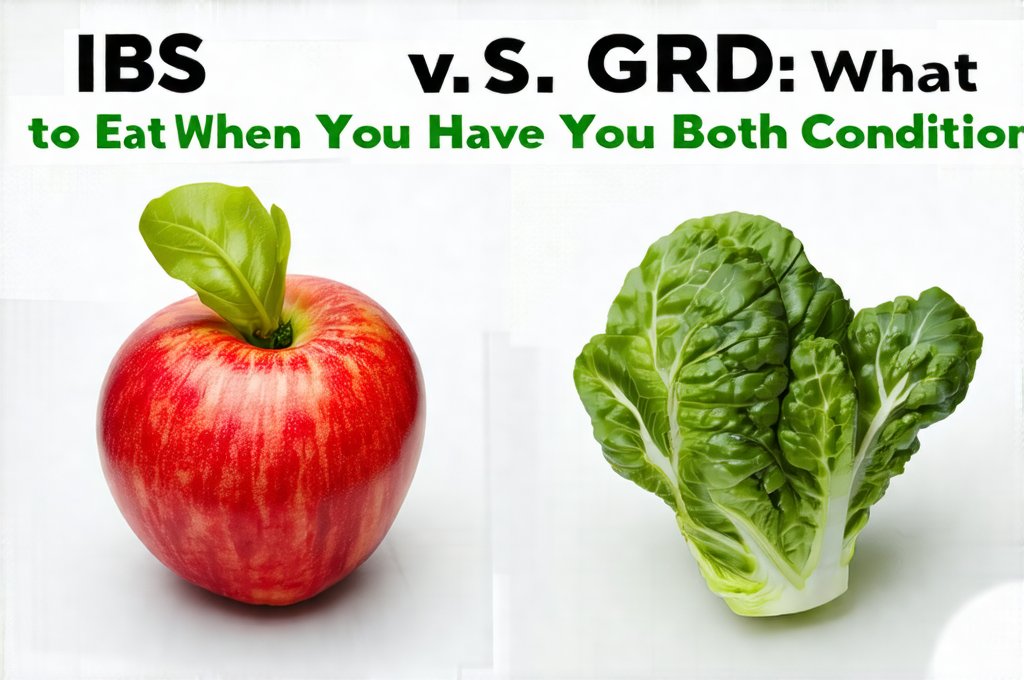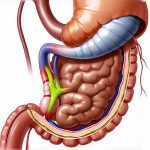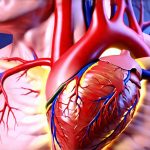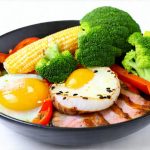Navigating digestive discomfort can feel like deciphering a complex code, especially when symptoms overlap between different conditions. Irritable Bowel Syndrome (IBS) and Gastroesophageal Reflux Disease (GERD) are two common culprits behind a wide range of gastrointestinal woes, often leading to frustration as individuals struggle to pinpoint the source – or sources – of their distress. What makes things even more challenging is that these conditions frequently coexist; someone can absolutely experience both IBS and GERD simultaneously, making dietary management particularly intricate. Understanding how each condition impacts digestion and what foods tend to exacerbate symptoms is crucial, but when you’re dealing with both, it requires a nuanced approach to eating that addresses the unique needs of each system.
Many people assume digestive issues are simply “one thing or another,” leading to generalized diet changes that may offer limited relief – or even worsen things. For example, eliminating all acidic foods might help with GERD but could trigger IBS symptoms in some individuals. Similarly, a high-fiber diet championed for IBS can sometimes aggravate reflux. This article dives deep into the relationship between IBS and GERD, focusing on practical dietary strategies that acknowledge the complexities of having both conditions. We’ll explore how to identify your personal triggers, build a balanced eating plan, and ultimately reclaim control over your digestive health. It’s about finding personalized solutions, not restrictive rules, to live comfortably and enjoy food again. If you are travelling with sensitive gut, remember to pack for travel appropriately.
Understanding IBS and GERD: A Digestive Duo
IBS is a functional gastrointestinal disorder, meaning there’s an issue with how the gut functions rather than structural damage. It affects the large intestine and causes symptoms like abdominal pain, bloating, gas, diarrhea, constipation, or alternating between both. The exact cause of IBS isn’t fully understood, but it’s believed to involve a combination of factors including visceral hypersensitivity (an increased sensitivity to sensations in the gut), motility issues (problems with how food moves through the digestive tract), gut microbiota imbalances, and psychological stress. Different subtypes exist – IBS-D (diarrhea predominant), IBS-C (constipation predominant), and IBS-M (mixed) – each requiring slightly different dietary approaches.
GERD, on the other hand, occurs when stomach acid frequently flows back into the esophagus, irritating its lining. This happens because of a malfunctioning lower esophageal sphincter (LES), a muscle that normally prevents acid reflux. While occasional heartburn is common, GERD involves persistent symptoms like heartburn, regurgitation, difficulty swallowing, and sometimes even chest pain. Factors contributing to GERD include diet, obesity, hiatal hernia, pregnancy, smoking, and certain medications. Unlike IBS, GERD often causes physical damage over time if left unmanaged. Understanding what happens when you eat foods you’re sensitive to can help you avoid flare ups.
The connection between the two isn’t always straightforward, but there’s growing evidence of a bidirectional relationship. For instance, chronic inflammation from GERD could potentially impact gut motility and contribute to IBS symptoms, while stress associated with managing IBS can exacerbate reflux. Moreover, dietary changes made for one condition might inadvertently worsen the other, creating a vicious cycle of discomfort. This is why it’s so important to consider both conditions simultaneously when crafting your eating plan.
Dietary Strategies When You Have Both IBS and GERD
Successfully navigating these two conditions requires more than simply avoiding “bad” foods; it’s about identifying your specific triggers and building a balanced diet that minimizes symptoms for both IBS and GERD. A cornerstone of this approach is the elimination diet, done thoughtfully and ideally with guidance from a registered dietitian or healthcare professional. This involves removing potential trigger foods for a period (typically 2-6 weeks) and then reintroducing them one at a time to observe your body’s response.
For GERD, common triggers include: fatty foods, chocolate, caffeine, alcohol, mint, spicy foods, citrus fruits, tomatoes, carbonated beverages, and large meals. For IBS, the list is more individualized but often includes: FODMAPs (fermentable oligosaccharides, disaccharides, monosaccharides, and polyols – found in many common foods), gluten, dairy, artificial sweeteners, and highly processed foods. The Low-FODMAP diet is particularly effective for managing IBS symptoms in many people. Combining these considerations requires careful planning. For example, while tomatoes are a GERD trigger for some, they might be tolerated by someone with IBS; conversely, onions (high FODMAP) could worsen IBS but not necessarily impact GERD. It’s important to know what not to eat when recovering from food related illness as well.
Beyond elimination diets, smaller, more frequent meals can help reduce both reflux and bloating. Staying hydrated is also crucial. However, avoid drinking large amounts of liquid with meals, as this can increase stomach pressure and contribute to reflux. Chewing food thoroughly aids digestion and reduces the workload on your gut. Finally, mindful eating – paying attention to hunger cues and savoring each bite – can help prevent overeating and reduce stress, both of which can worsen symptoms.
Identifying Personal Triggers: A Step-by-Step Approach
Pinpointing your individual triggers is paramount for long-term management. Here’s a structured approach:
- Food Diary: Keep a detailed food diary for at least two weeks, recording everything you eat and drink, along with any associated symptoms (pain, bloating, heartburn, diarrhea, constipation). Be specific – note the quantity of food consumed and the timing of symptoms relative to meals.
- Elimination Diet: Under professional guidance, eliminate common triggers for both IBS and GERD for 2-6 weeks. Focus on a baseline diet consisting of easily digestible foods like rice, chicken, steamed vegetables, and lactose-free dairy alternatives.
- Reintroduction Phase: Slowly reintroduce one food at a time, every 3-4 days, while continuing to monitor your symptoms. Start with small portions and observe how your body reacts before adding another food. If a food causes significant discomfort, remove it from your diet for a period.
The Role of Fiber in IBS & GERD Management
Fiber is often touted as beneficial for digestive health, but its role becomes complicated when you have both IBS and GERD. Insoluble fiber (found in whole grains, vegetables) can bulk up stool and help relieve constipation in some IBS-C sufferers, but it might also exacerbate bloating and gas. Soluble fiber (found in oats, fruits) is generally better tolerated by people with IBS and can help regulate bowel movements. However, high-fiber foods can sometimes worsen GERD symptoms by increasing pressure on the LES or slowing down gastric emptying.
- Start slowly: If you’re adding fiber to your diet, do so gradually to avoid sudden increases in gas and bloating.
- Choose soluble fiber: Prioritize sources of soluble fiber over insoluble fiber, especially if you’re prone to constipation.
- Hydrate adequately: Drink plenty of water when increasing your fiber intake to prevent constipation.
- Consider low-FODMAP options: If you have IBS, explore low-FODMAP sources of fiber like oats, carrots, and blueberries.
Lifestyle Factors That Impact Both Conditions
Diet isn’t the only piece of the puzzle. Several lifestyle factors can significantly impact both IBS and GERD symptoms:
- Stress Management: Chronic stress can worsen both conditions. Practice relaxation techniques like yoga, meditation, deep breathing exercises, or spending time in nature.
- Regular Exercise: Physical activity promotes healthy digestion and reduces stress, but avoid strenuous exercise immediately after eating.
- Weight Management: Obesity increases the risk of GERD and can exacerbate IBS symptoms. Maintaining a healthy weight through diet and exercise is crucial.
- Sleep Hygiene: Aim for 7-8 hours of quality sleep each night. Poor sleep can disrupt digestion and worsen both conditions.
- Proper Posture: Avoid lying down immediately after eating, as this increases the risk of reflux. Elevate the head of your bed by a few inches if you frequently experience nighttime heartburn.
It’s important to remember that managing IBS and GERD simultaneously is a journey, not a destination. There will be ups and downs, and it may take time to find what works best for you. Don’t hesitate to seek guidance from healthcare professionals – a registered dietitian can help you develop a personalized eating plan, while your doctor can provide medical advice and monitor your progress. Be patient with yourself, listen to your body, and celebrate small victories along the way. If you are starting probiotics, be aware that some people experience worsening symptoms initially. Understanding what to eat when recovering from an indigestion episode can also provide relief, and knowing acid reflux triggers is vital for a balanced diet. When preparing for events, consider what to bring to a potluck with dietary restrictions.


















